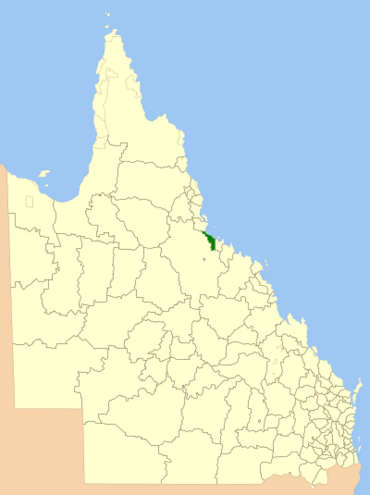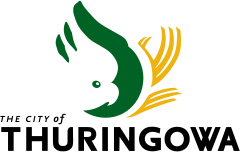City of Thuringowa facts for kids
Quick facts for kids Former City of ThuringowaQueensland |
|
|---|---|

Location within Queensland
|
|
| Population | 59,164 (2006 census) |
| • Density | 31.6910/km2 (82.079/sq mi) |
| Established | 1846 1st Settlement, 1879–1903 Division, 1903–1986 Shire, 1986–2008 City. |
| Area | 1,866.9 km2 (720.8 sq mi) |
| Region | W/SW from Townsville |
 |
|
| Website | Former City of Thuringowa |
The City of Thuringowa (19°18′26″S 146°43′54″E / 19.30722°S 146.73167°E) was a city and local government area in North Queensland, Australia. It covered the northern and western parts of what is now Townsville. The main business area in Thuringowa was a suburb called Thuringowa Central.
Thuringowa got its name from Thuringia, a state in Germany. This is where the first chairman of the area, John von Stieglitz, came from. Before it became a city on January 1, 1986, Thuringowa was a large rural area, almost surrounding the City of Townsville.
In 2007, the Queensland Government decided to combine the Thuringowa City Council with the Townsville City Council. The new combined city was called the New Townsville City. This change was completed when a new council was elected on March 15, 2008.
Contents
History of Thuringowa
Early Beginnings
Before Europeans arrived, the Nyawaygi Aboriginal people lived in the area. This included the land around Thuringowa and Townsville. The first European known to live in Thuringowa was James Morrill. His boat washed ashore in 1846.
In 1860, the Queensland Government allowed people to lease land for farming. By 1861, many farms were set up in Thuringowa. In 1865, Robert Towns and John Melton Black bought several properties. Robert Towns built a "boiling down" factory. This factory processed animals because there were no shipping facilities for cattle or sheep.
Later in 1865, Andrew Ball and Mark Reid looked for a good harbour. They found one around Cleveland Bay. This led to the establishment of the town and port of Townsville at the mouth of Ross Creek.
Population Growth
Thuringowa's population grew very quickly from the 1980s. It became one of the fastest-growing cities in Australia. The number of people living there increased from 26,000 in 1986 to over 65,000 by 2007.
The table below shows how the population of Thuringowa changed over the years:
| Year | Population | Growth per year |
|---|---|---|
| 1936 | 1,500 | |
| 1954 | 2,627 | |
| 1961 | 2,572 | |
| 1966 | 2,863 | 2.17% |
| 1971 | 3,432 | 3.69% |
| 1976 | 10,914 | 26.03% |
| 1981 | 17,728 | 10.19% |
| 1986 | 30,104 | 11.17% |
| 1991 | 37,722 | 4.62% |
| 1996 | 44,319 | 3.27% |
| 2001 | 52,715 | 2.90% |
| 2006 | 62,935 | 2.96% |
| 2007 | 65,782 | 4.5% |
Areas and Suburbs
The City of Thuringowa included many different towns and areas. These were divided into urban (city-like) and rural (countryside) places.
|
|
Leaders of Thuringowa
The City of Thuringowa had many leaders over its history. These leaders were called chairmen or mayors. They helped manage the local government area from 1880 until 2008.
Here is a list of some of the people who led Thuringowa:
|
|
See also
 In Spanish: Thuringowa para niños
In Spanish: Thuringowa para niños


